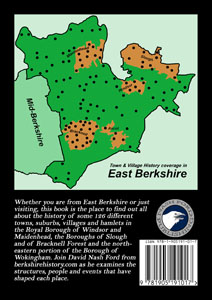 |
 |
||||||||
|
|
 Waltham
St. Lawrence Waltham
St. LawrenceOlds Pubs & Publishers The earliest residents of Waltham St Lawrence seem to have lived on Weycock Hill, between the village and Kiln Green. The name stems from Weg-Cocc meaning Wayside Hillock. Despite the later appendage of the word hill, there is not much of an incline there. The ‘way’ would be the Roman Camlet Way, running from St Albans (Verulamium) to Silchester (Calleva) which passed close by. The hillock was probably all that remained to show where a Roman temple had once stood. This was a vast octagonal building, excavated in the late 19th century, which can still be easily identified by aerial photography. Associated finds have led to the suggestion that it was dedicated to the Roman goddess, Vesta, or her Celtic equivalent. There would have been a substantial settlement nearby, full of shops and hotels for visiting pilgrims. This is reflected in the name of the parish, Waltham. Despite alternative interpretations being popular, the name almost certainly stems from Wealt-Ham, referring to the Dilapidated Homes of the Romans that the incoming Anglo-Saxons discovered. St Lawrence is the church dedication: hence the village’s ancient alternative name of Lawrence Waltham. Traditionally, the north doorway of the church is called the Devil’s Door. It is said that when the vicar enters the church’s south door, the Devil exits through the north and into his shadowy side of the churchyard. Outside the southern lychgate is the old wooden pound for stray animals – a rare survival in Berkshire. The beautiful old Bell Inn nearby is also unusual for this area. It is a fine example of a medieval ‘Wealden’ hall-house, usually found in Sussex. It was given to the church by the prominent 16th century publisher, Ralph Newbery, who lived at Beenham’s Heath. He rose to become Master of the Royal Printing House and many of the family from Waltham were subsequently publishers and booksellers in St Paul’s Churchyard in London. John Newbery, a descendant of Ralph’s brother, is known as the ‘Father of Children’s Literature’ as he published the first ever range of books for children in the mid-18th century. He is particularly revered in the United States, where the John Newbery Medal is awarded each year for the “most distinguished contribution to American literature for children”. He was born in Waltham St Lawrence and started out publishing the Reading Mercury newspaper in Reading Market Place before moving to London. He is buried beneath a prominent tomb chest in Waltham St Lawrence Churchyard. The parish registers show burials of soldiers from both sides during the Civil War, for there was supposedly a skirmish of some kind at Beenham’s Heath. The village was certainly deeply divided at this time: Richard Neville, the lord of the manor, was a royalist while his own brother was a staunch parliamentarian. The Nevilles were descendants of the Barons Bergavenny and, through them, of the great Neville family of County Durham (and Bisham). They lived at Billingbear Park, just within the southern bounds of the parish, which Henry Neville built in 1567. His son and namesake was a famous Elizabethan diplomat who had a monopoly on manufacturing British cannon. Both father and son feature on the former’s fine kneeling-figured mural monument in the parish church, though their house is no more. Read more history of
Waltham St. Lawrence and other settlements in the parish in David Nash Ford's book, 'East Berkshire Town and
Village Histories'.
|
||||||||
| © Nash Ford Publishing 2001; Revised 2020. All Rights Reserved. | |||||||||




